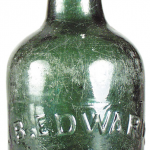As you sit back and enjoy a cold bottle of beer, did you ever wonder how long beer in bottles has been around and how they have evolved. The first glass bottles for beer appeared sometime in the 1700's but were much more primitive than today. They were handmade of thick dark glass much like the liquor and wine bottles of the day. This was long before the bottle cap or crown you know today so the bottle was plugged with a cork, like many wine bottles are today. This continued into the 1800's when porcelain stoppers with a metal swing replaced corks. However, the bottles of the 1800's were far from uniform, taking on many different shapes and sizes. There was no paper labeling in those days so the name and location of the brewer was embossed into the glass so the consumer knew where the beer was coming from. William painter invented the bottle crown (they look like a crown when laying upside down) with a cork backing in the 1890's. As mass produced bottles began appearing in the early 1900's, the crown became the closure of choice. Cork backed crowns were used well into the sixties or early seventies before cheaper and readily available plastic back crowns replaced them for good. Late 1800's and early 1900's bottles also began using paper labels that could use limitless color and artwork as well as allow the brewer to sell different brands and flavors. Standard returnable longnecks began to appear before Prohibition in 1919 and were the bottle of choice when the great experiment ended in 1933. When beer in cans arrived in 1935, the glass industry knew it was at war. Cans offered many key selling points. They were lighter weight, easier to stack in the fridge, and light, a true enemy of beer, could not penetrate them. Best of all, they were one way, so no empties to return-just throw them away. The glass industry responded with one-way stubbies, a shorter, fatter throwaway bottle. During the fifties and sixties, many breweries advertised this package as "glass cans." The quart bottle made it's big appearance during World War II when glass and especially metal were being rationed for the war effort. Breweries begged people to buy beer in quart bottles to save metal used in caps since almost three bottles were available in one quart, hence one cap instead of three. The bottle was the only package used for beer during the war as can production was stopped except for those sent to troops overseas. The war between can and bottled beer continued into the fifties, sixties, and seventies before the sales of canned beer finally outsold bottled beer. However, the beer bottle remains a viable package in today's market and many still believe bottled beer is better than canned beer. Personally, I believe canned beer is a better product, mainly because of the effect light has on beer in glass.
By: Brent Bernett, General Sales Manager, G&M Distributors, Inc.


